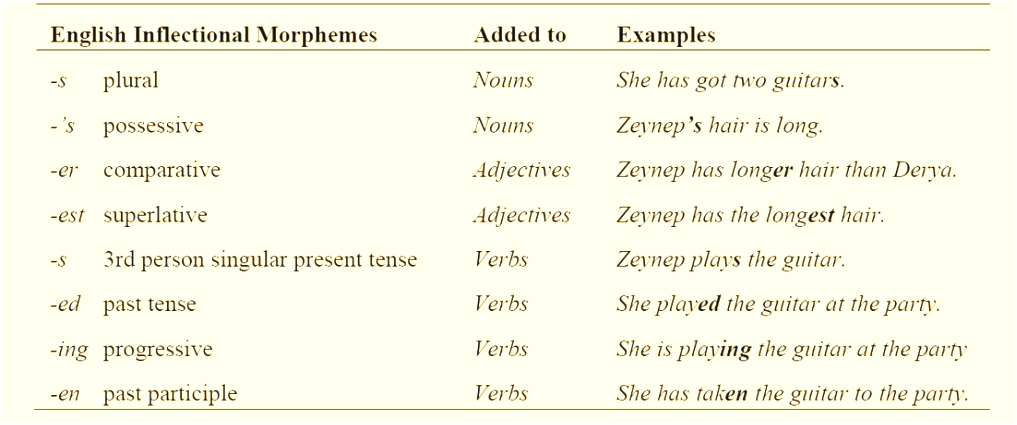Derivational and Inflectional Morpheme

Hello again. Today I want to explain about derivational and inflectional morpheme, it's the one of morphology study.
Morphology deals with the structure of words or the study of the structure of words. So, it's relate to vocabulary building. The smallest unit of English language called morpheme. Morpheme is the central of all vocabulary building. There are lots of way to build a word and maybe I will write about them later, but lets focus on the most common way that lexical use, that is derivational and inflectional.
1. Morpheme
Morpheme is the smallest unit of English. There are 2 kind of morphemes, there are free morpheme and bound morpheme. Free morpheme is the morpheme that can stand by itself, or on the other words, it has it's own meaning even though it's not attach to the other morpheme.
Take an example, the word "cat, study, manage, rich, and happy". These are free morpheme because it has it's own meaning.
Different with free morpheme, bound morpheme must be attached to the other words that aims to have a meaning. The morpheme "s, ing, en, ness". You might be confused to translate these words. But what about I attached it to the free morpheme.
The word cat above, will attach with s = cats
Study attach with ing = Studying
en + rich = enrich
Happy + ness = happiness
Can you see the difference ? After I add the bound morpheme, those free morpheme have " new meaning" and might be have different grammatical class. To be clear, let's see the image below.

From the explanation above, we know that bound morpheme is the kind of affixes. Affixes can be at the begin or at the end of word, or might be both of them. The affixes that locate at the beginning of word called prefix, at the end of the word called suffixes, and at the beginning and at the end of word called circumfix. There is also the affixes that located at the middle of the word, called infix. But infix is not use in the English language.
The example of affixes :
- Prefix = un-believe= Unbelieve
-Suffix = play-ful = Playful
-Circumfix = Un-leash-ed= Unleashed
2. Derivational Morpheme
Derivation is the accomplished process by means of a large number of affixes of English language which are not usually given separate listings in dictionaries (Yule, 2006:57).
From the Yule explanation above, it can be concluded that Derivation is the process by adding affixes in English language which usually not usually appear in dictionary. If there's no appear in vocabulary, then how we know the words that have derivation process in formulating them? You can enrich your vocabulary by reading the book in English, listening podcast, or youtube video that you might be like. Because it's easier rather than memorize all of the derivational morpheme in your head.
Derivational morpheme can change both meaning and might be grammatical structure of the words. And there some rules in derivational process. Take an example, if we add -re- at the beginning of word, the words will have meaning-again-, such as in the words re-search, re-read, and re-do. Same goes with the morpheme- un, which means -no, such as in the words un-predictable, un-likely, and un-happy.
Here is a few example are the elements un-, mis-, -ful, less which appear in unhappy, misrepresent, joyful, careless, according to Yule.
a. Negative Prefix un- →Unhappy (Yule, 2006:57)
b. mis- →Misrepresent (Yule, 2006:57)
c. Suffix changes the word class (noun → adjective) -ism →Terrorism (Yule, 2006:57)
d. -ish→ Boyish (Yule, 2006:57)
According to Fromkin, a single word may be composed of one or more morphemes:
One morpheme boy desire meditate
two morphemes boy + ish desire + able meditate + tion
three morphemes boy + ish + ness desire + able + ity
four morphemes gentle + man + li + ness un + desire + able + ity
more than four un + gentle + man + li + ness anti + dis + establish + ment + ari + an + ism
It can be concluded that one word might be have more than one affixes, but remember, there are some rules to do this formation. For your further reading and clearer explanation in rules of derivational and the other word formation, you can read in " The Grammar of Words" that was written by Geert Boij. You can download it for free.
3. Inflectional Morpheme
Inflection is a word formation by adding affixes so that it can create new form without changing the word class or meaning (Hatch and Brown, 1995:285).

Komentar
Posting Komentar